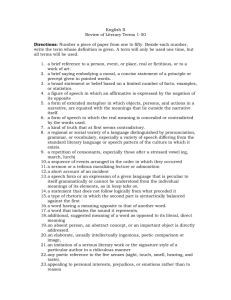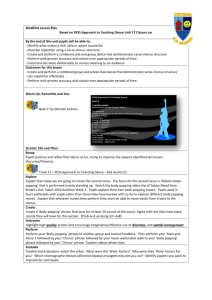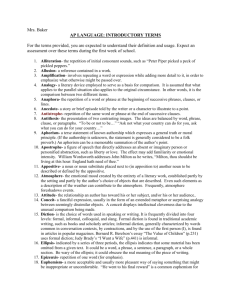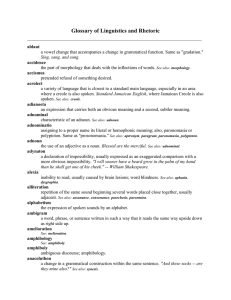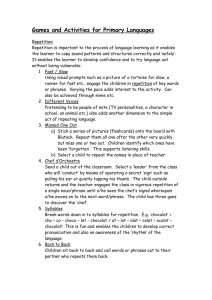Repetition - Dane Court Grammar School
advertisement
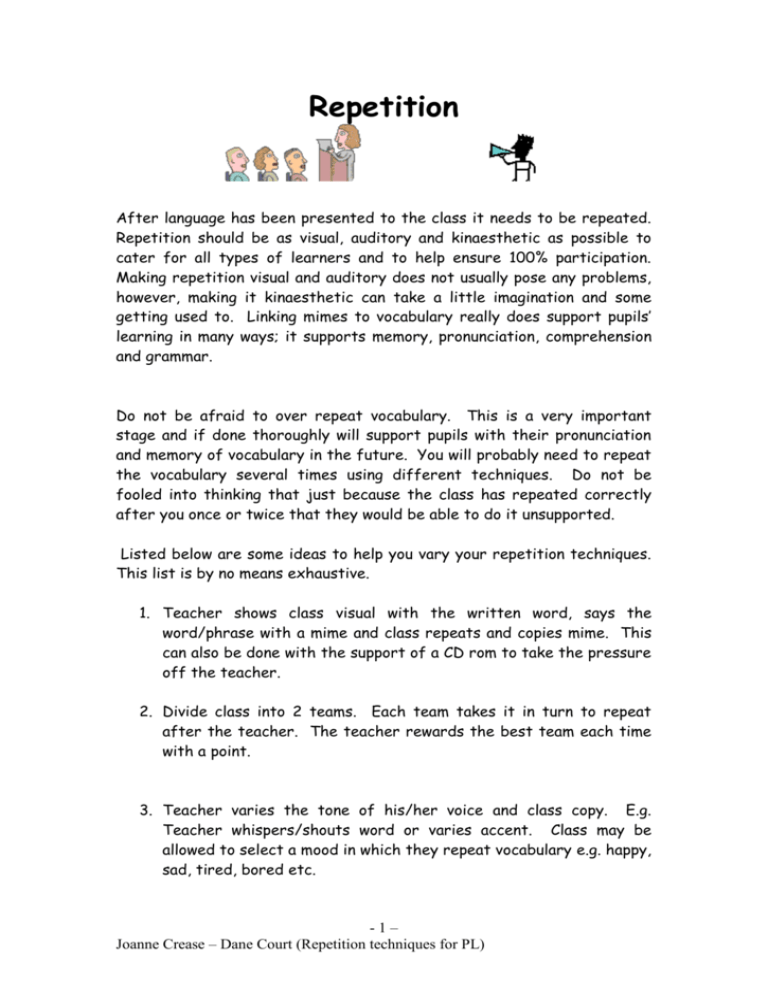
Repetition After language has been presented to the class it needs to be repeated. Repetition should be as visual, auditory and kinaesthetic as possible to cater for all types of learners and to help ensure 100% participation. Making repetition visual and auditory does not usually pose any problems, however, making it kinaesthetic can take a little imagination and some getting used to. Linking mimes to vocabulary really does support pupils’ learning in many ways; it supports memory, pronunciation, comprehension and grammar. Do not be afraid to over repeat vocabulary. This is a very important stage and if done thoroughly will support pupils with their pronunciation and memory of vocabulary in the future. You will probably need to repeat the vocabulary several times using different techniques. Do not be fooled into thinking that just because the class has repeated correctly after you once or twice that they would be able to do it unsupported. Listed below are some ideas to help you vary your repetition techniques. This list is by no means exhaustive. 1. Teacher shows class visual with the written word, says the word/phrase with a mime and class repeats and copies mime. This can also be done with the support of a CD rom to take the pressure off the teacher. 2. Divide class into 2 teams. Each team takes it in turn to repeat after the teacher. The teacher rewards the best team each time with a point. 3. Teacher varies the tone of his/her voice and class copy. E.g. Teacher whispers/shouts word or varies accent. Class may be allowed to select a mood in which they repeat vocabulary e.g. happy, sad, tired, bored etc. -1– Joanne Crease – Dane Court (Repetition techniques for PL) 4. With long or difficult words teacher divides them up into syllables and repeats them one syllable at a time. Teacher may also give different rows/tables/groups of children a syllable from a word to repeat and when they are pointed to they say their syllable. 5. Repeat if true. Teacher shows visual and phrase. Class only repeat the phrase/word if it matches what the teacher is showing. This can be turned into a game by having everyone standing up and the ones who get it wrong have to sit down. 6. Repeat if true. Teacher does mime and says word/phrase. Pupils only repeat it if the mime matches the word/phrase. As above (No5) this can be turned into a whole class game. 7. Beat the teacher. Class count how many times teacher can manage to say a word/phrase in 5 seconds. Then the teacher times the class to see how many times pupils can say it. Select some of pupils who “beat the teacher” to demonstrate to the rest of the class. 8. Teacher mouths word/phrase to class and they have to say it. 9. Teacher gives alternative ways of pronouncing a word – class has to vote on the right way or only repeat if it is said the correct way. 10. Teacher pronounces words using different accents or voices. Class can vote on which voice/accent they want to use to repeat the vocabulary. 11. Teacher repeats the vocabulary in the same order as it was presented. The class has to guess which one comes next. 12. Teacher repeats and goes through vocabulary with class and misses one out. Class has to guess which one is missing 13. American soldier chanting. Teacher chants vocabulary to an American soldier chant and the class repeat the chant. -2– Joanne Crease – Dane Court (Repetition techniques for PL) 14. Putting the vocabulary into a song. Teacher sings song and class repeat. Short questions and phrases often fit well to the music of well known nursery rhymes and children’s songs such as London’s Burning, Three blind mice, Old MacDonald etc. 15. To repeat short dialogues divide class into 2 halves and repeat dialogue with each half taking a different role then swap. The best team can be rewarded for their performance. 16. Ask for a volunteer in the class and send him/her out. Ask for another volunteer from the rest of the class. This volunteer will secretly give the signal to the rest of the class that they need to go on to the next word/phrase from the list that they are repeating. The signal can be scratching his/her head, yawning etc. The volunteer who was sent outside is invited in. He/she has to work out who is giving the signal and who it is. The list could be a list of dates. E.g. lundi six octobre mardi deux mai vendredi douze juin dimanche trente janvier -3– Joanne Crease – Dane Court (Repetition techniques for PL)

